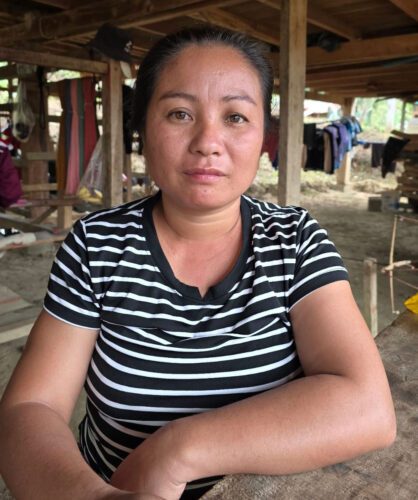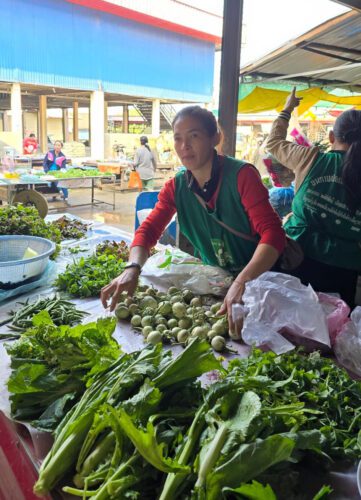“Now I get tired easily,” shares Ms. Hueang Namixay, a 36-year-old woman farmer from Laos, who suffered from pesticide poisoning. A lowland farmer, Hueang has been using the herbicide glyphosate in her four-hectare farm in Namhom Village in Kham District, Xiengkhuang Province, for 17 years to grow maize.
 She was aware of the perils of pesticide use. Previously the family farm, which is on ancestral land, was a paddy field requiring no chemicals to grow crops. Transitioning to maize to be used as animal feed, she felt she had no choice. It was a large farm that would grow only a single crop, and using glyphosate would allow her to manage the weeds so that she could get a higher yield.
She was aware of the perils of pesticide use. Previously the family farm, which is on ancestral land, was a paddy field requiring no chemicals to grow crops. Transitioning to maize to be used as animal feed, she felt she had no choice. It was a large farm that would grow only a single crop, and using glyphosate would allow her to manage the weeds so that she could get a higher yield.
The intensive use however led to increasing resistance in the weeds, inevitably requiring more pesticides. With her constant exposure to the chemical, Hueang started to experience skin disorders such as painful blisters, red rashes, and breakouts that she now has to treat with regular skin medication. When she inhaled the chemicals while preparing the herbicide, she experienced headache, dizziness, and weakness throughout her body.
Pesticide poisoning is a serious public health problem with grave consequences–and it’s far more common than we think. In fact a systematic review of mortality data from 141 countries show that 44% of farmers worldwide are poisoned by pesticides every year, with the greatest estimated number of acute cases coming from countries in South Asia and Southeast Asia.(1)
In Laos, where 80% of the population relies on agriculture, the sector’s growing commercialization has led to a significant increase in pesticide application. Overuse has become widespread and contamination the norm. Knowledge on how to farm naturally is now being eroded despite the country’s long history of chemical-free farming.(2)
“I would like to see the reduced use of pesticides. I want my village to stop using pesticides,” says Hueang, who over time saw her soil lose vitality, lacking nutrients and becoming hard, which required her to buy more inputs, as productivity declined. There is also a marked decrease in local fauna and there’s fewer fish in the river, affecting her family’s ability to find food.
To address the low productivity, biodiversity loss, nutrient deficiencies, and environmental degradation that have become inevitable with pesticide use in different parts of Laos, particularly in Xiengkhuang Province, IPAM field learning site Sustainable Agriculture and Environment Development Association (SAEDA) promotes the adoption of agroecology as the alternative to chemical farming through knowledge sharing and skills training in vulnerable communities like women and small-scale farmers.
 One such farmer who has received support from SAEDA is Ms. Bouakeo Mamatavong, a 38-year-old lowland farmer who comes from Khaiy village in Paek district as Hueang. Among the things she learned from SAEDA are plant breeding and seed conservation, diverse crop production and livestock integration, and pest and disease management. She practices integrated farming to be able to forgo the use of fertilizers and pesticides in her farming, relying instead on what is available in her farm to be able to grow organic food.
One such farmer who has received support from SAEDA is Ms. Bouakeo Mamatavong, a 38-year-old lowland farmer who comes from Khaiy village in Paek district as Hueang. Among the things she learned from SAEDA are plant breeding and seed conservation, diverse crop production and livestock integration, and pest and disease management. She practices integrated farming to be able to forgo the use of fertilizers and pesticides in her farming, relying instead on what is available in her farm to be able to grow organic food.
Bouakeo’s story is a testament to how agroecology is more than a farming practice–it is a continuous praxis of reclaiming farmers’ sources of sovereignty and power.
Farming this way for close to a decade, Bouakeo has found that not only does this protect her personal and family’s health, but the land continues to be fertile, there is water all year round, and there are a lot of insects for pest management and pollination. Even during the pandemic, they were able to eat well. “We don’t get sick easily. Since we grow vegetables and raise animals together there are no health issues, and the most crucial thing during the Covid pandemic is that there was enough food to eat in my family.”
Bouakeo saves her own seeds and makes her own fertilizers, fostering a strong sense of autonomy over her production. She does not need to spend on toxic pesticides and chemical inputs, lowering her investment and supplementing her income as a kindergarten teacher. She tends to her farm daily after work then sells her harvest at the organic market once a week, every Saturday. Even if sometimes the biopesticides cannot control the harmful pests, “the vegetables grown are of good quantity and quality,” for which she is able to get a good price and help improve her family’s economic stability. She hopes SAEDA can help improve agroecological farmers’ access to more markets “that value and support sustainable and environmentally friendly agricultural products, as well as fair prices for our produce.”
When asked how agroecology has empowered her, Bouakeo shares that it enables women to “take charge of her own life” because with agroecology, women like her get to be active in decision making and have access to various resources that affect their ability to grow food.
She has many plans for her farm. “I’m going to keep adding plants and expanding the garden. In order to cultivate superior crops during the rainy season, I intend to construct an additional shade house. In order to keep an eye on what will fetch a good price, I also need to cultivate vegetables according to the season and demand.”
Bouakeo is a portrait of a woman farmer transformed by agroecology. SAEDA’s work ensures that there are more like her. It is a transformation she wishes to share with everyone who wants to leave behind chemical farming. “I can help guide them and my farm is a place where people who are interested can come to visit.”##
(1) Boedeker W, Watts M, Clausing P, Marquez E. The global distribution of acute unintentional pesticide poisoning: estimations based on a systematic review. BMC Public Health. 2020 Dec 7;20(1):1875. doi: 10.1186/s12889-020-09939-0. PMID: 33287770; PMCID: PMC7720593. Accessed April 24, 2024.
(2) Rassapong S, Syfongxay C, Phanthanivong I et al. Briefing Note: Pesticide Use in Lao PDR: Health and Environmental Impacts. Ministry of Agriculture and Forestry and Swiss Agency for Development and Cooperation. January 2018.


